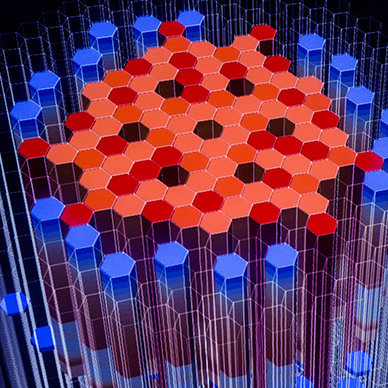
Sodium-cooled fast reactors (SFR)

Using sodium as a coolant makes transmutation possible
The CEA is actively committed to research on these fourth generation reactors. At IRESNE, we have devoted part of our research to investigating this fast reactor technology, more specifically with liquid sodium as the coolant (S being the chemical symbol for sodium). There are also other fluid coolants that can replace sodium, such as gas, lead and molten salts, which are also studied by our IRESNE.
The advantages of sodium
Sodium offers real advantages as a fluid coolant which justify this choice and commitment from our researchers:
-
Good thermal properties:
Sodium has the advantage of high thermal inertia, which can be used to absorb and efficiently remove the heat generated in the reactor core. It boasts a high heat capacity and good thermal conductivity.
-
Low viscosity:
Sodium also boasts low viscosity, which means it does not require high pumping power.
-
No need to be pressurised:
Contrary to water, sodium does not need to be pressurised. This is because its boiling temperature is much higher than the reactor’s operating temperature.
-
Low neutron activation:
Sodium is only slightly activated by neutrons, which means that large quantities of radioactive waste will not be produced.
-
Very good compatibility with materials:
Sodium is not very corrosive, making it compatible with steels and avoiding the early deteriorating of reactor structures.
-
Purification (filtering):
The fluid coolant must not degrade under the effect of irradiation or become overly radioactive so reactor maintenance and eventually dismantling can be carried out with relative ease. More than often, activation is caused by impurities in the coolant. It is therefore important to be able to keep the sodium sufficiently clean during reactor operations.
The CEA - more specifically thanks to its teams at IRESNE - has developed processes to purify sodium and control its impurity levels. The two main devices used in these processes are the cold trap and the plugging indicator. Some measuring instruments have also been developed to better understand the sources of pollution and to monitor the quality of sodium during reactor operation.
-
Economical and available:
Sodium has no availability issues and can be procured at low cost, which makes it a very interesting coolant.
Disadvantages of sodium as a coolant
Sodium offers many advantages when used as a coolant. However, it also has several disadvantages that must be managed:
-
It is a highly reactive chemical product:
Sodium has a very strong reaction with water and oxygen in the air. It can ignite spontaneously in air and reacts violently in contact with water, which produces explosive hydrogen gas. Very specific precautions are required to prevent sodium fires and sodium-water interactions from occurring.
-
Opaque liquid:
Liquid sodium is not transparent. The periodic inspection of surfaces inside the reactor vessel, the identification of components, and the search for foreign objects in a sodium environment are complex tasks to perform. Faced with these difficulties, IRESNE set about developing a set of innovative instruments capable of overcoming these issues.
The use of sodium calls for specific, in-depth research on the design and operation of reactors using this coolant.